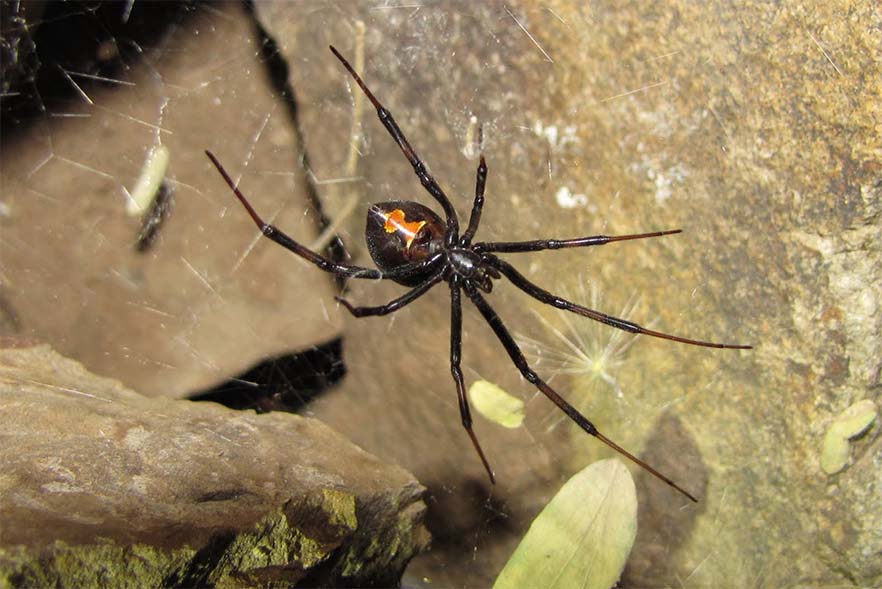
The Western Black Widow: Characteristics, Types, & Prevention
The Western Black Widow or Latrodectus hesperus is a species of venomous spider native to North America, which can be found in the western regions of Canada, the United States, and Mexico, including California, Arizona, Oregon, Washington, Idaho, and Utah. These spiders are known to be dangerous and even deadly due to their potent venom and their tendency to bite when disturbed.
Physical Characteristics
The Western Black Widow is identified by its distinctive appearance, distinguishing it from other spiders in the region. Adult female spiders are shiny black, with a characteristic red hourglass-shaped marking on the underside of their abdomen. Males are smaller, usually reddish-brown, and do not have the hourglass marking.
When fully grown, female Western Black Widows range from 1/4” to 1/2” in length, with males being smaller, only up to 1/4” in length. The females are typically larger and more dangerous than the males, producing a more potent venom.
Habitat
The Western Black Widow thrives in dry, arid regions such as deserts and grasslands. These spiders often inhabit dark, sheltered areas such as crevices, burrows, and tree holes. They are also commonly found in human-made structures such as sheds, garages, and outdoor toilets. Around your home, they can be found hiding under siding, stucco, window wells, and even yard furniture.
Behavior
The Western Black Widow is primarily a nocturnal hunter, remaining inactive during the day and hunting at night. They feed on various insects, including beetles, flies, and moths. The female spiders are also known to eat their male partners after mating, a process known as sexual cannibalism.
The spider typically retreats to a safe spot, such as a burrow or crevice, when disturbed. However, they will often bite in self-defense if they feel threatened or cornered. A Western Black Widow’s bite is considered dangerous and potentially life-threatening.
Venomous Bite
The venom of the Western Black Widow contains a potent neurotoxin that affects the victim’s nervous system. A female Western Black Widow’s bite is considered potentially fatal, particularly for young children and the elderly. Symptoms of a bite can include severe pain, muscle spasms, nausea, vomiting, abdominal cramps, and difficulty breathing.
In severe cases, the venom can cause paralysis and even death. However, despite the potency of their venom, fatalities from Western Black Widow bites are extremely rare, as the spiders tend to avoid humans and will only bite when they feel threatened. The last recorded fatality from any widow species last occurred in 1983.
Prevention
To prevent being bitten by a Western Black Widow, it is vital to take steps to reduce the risk of encountering them. This includes wearing protective clothing when working in or around suspected areas, such as gloves, long sleeves, and pants. Keeping outdoor areas clean and clutter-free can help control populations, as spiders tend to avoid well-lit and clean areas.
It is important to note that if you do locate a Western Black Widow in your home or workplace, it is best to contact a professional pest control company to remove the spider rather than attempting to do so yourself.
Around your home, one of the best ways to control black widows is to control the populations of their food sources. If they can’t hunt and find food around your property, they will most likely move to a different location that can sustain them.
Insecticide treatments can effectively control widow spiders as long as the treatments are adequately applied to areas where the black widows tend to hide. It’s essential also to note that just because a widow spider may come in contact with a treatment area doesn’t mean it will die off immediately. It can take several hours after a spider contacts a treatment area to die. In most cases, they actually eat another insect in the treatment area, and then the black widows ingest the insecticide when they consume their prey.
Conclusion
The Western Black Widow is a potentially dangerous spider inhabiting North America’s western regions. Despite their reputation for being deadly, fatalities from Western Black Widow bites are rare. With proper precautions, it is possible to reduce the risk of encountering these spiders, particularly in areas with a higher incidence of their presence. If a Western Black Widow bites you, seek medical attention immediately, as their venom can cause severe symptoms.
Should you find yourself in a position where you are finding Black Widow spiders around your home or property, then we suggest calling us to schedule a consultation so we can discuss treatment plans that would help to keep your home pest and spider-free year-round.

